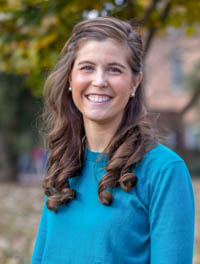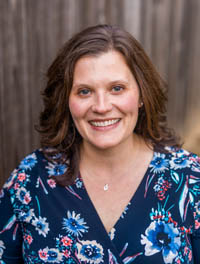Each year, The Graduate School honors graduate students in programs throughout our University for their powerful discoveries that contribute to a better future for people and communities in North Carolina. We're pleased to present 15 Impact Awards and five Horizon Awards for 2019.

Impact Award
The Cape Fear River is the primary source of drinking water for an estimated 250,000 residents in eastern and central North Carolina. In recent years, residents have raised questions and researchers have studied possible contamination involving chemicals named perfluoroalkyl substances (PFAS).
PFAS are industrially useful chemicals that make products stain- and grease-resistant — but they pose a major public health concern due to their associations with adverse health outcomes in adults, pregnant women and developing fetuses. One such PFAS, perfluorooctanoic acid (PFOA), has been phased out in the United States due to its effects on humans and the environment, yet it is still persistent in the environment. GenX is a replacement for PFOA, but its health effects are unknown.
Using the mouse as a research model, doctoral student Bevin Blake and colleagues investigated GenX and PFOA to compare the effects of these two compounds on maternal, fetal and placental outcomes. Their preliminary findings indicate that both PFOA and GenX disrupt gestational weight gain and placental development, with effects being more prominent with GenX. This suggests that certain aspects of maternal-fetal health may be especially vulnerable to GenX exposure.
Blake’s research is continuing. Her findings will enhance understanding of how common drinking water contaminants affect the most susceptible members of North Carolina’s population and will provide critical information needed to help regulatory agencies establish safe levels for unregulated compounds such as GenX.
“Bevin means to make a difference in the health of North Carolina communities and her research should provide important data for use in regulatory decision making,” said adviser Suzanne Fenton, Ph.D.

Impact Award
The Food, Fitness and Opportunity Research Collaborative at the UNC-Chapel Hill Center for Health Promotion and Disease Prevention has conducted healthy eating research for eight years in rural N.C. communities throughout Orange, Lenoir, Warren, Rockingham, Sampson and Duplin counties. Between March and August 2017, doctoral student Leah Chapman led an experiment within the collaborative, testing four interventions, or “nudges”: floor arrows guiding customers to the produce sections, signage in produce sections portraying a “limited amount” message, placement of granola bars into the candy bar aisle and the implementation of all interventions simultaneously.
She focused on two convenience stores and two grocery stores in Orange and Warren counties, in communities that had food insecurity rates of greater than 15 percent.
Chapman’s analysis of store sales data showed that implementing the three interventions simultaneously in a convenience store was associated with a 17-unit increase in sales of the promoted nutritious items — apples, bananas, oranges and granola bars — during the four-week intervention period, compared to baseline sales. No significant changes in sales were observed in the control convenience store. Additionally, she surveyed 243 shoppers in the grocery and convenience intervention stores, with significant majorities reporting that the intervention materials helped them find and purchase healthier food and made them more willing to buy healthy foods.
Chapman’s research is contributing to efforts to reduce diet-related chronic diseases among rural North Carolinians.
“Leah is committed to healthy food access for all North Carolinians, and her project shows promise in this area as well as providing economic development opportunities for retailers in rural communities,” said adviser Alice Ammerman, Dr.P.H.

Impact Award
North Carolina ranks fourth-highest nationwide for states with people potentially exposed to high levels of arsenic in their drinking water wells, according to a study from the U.S. Geological Survey and U.S. Centers for Disease Control and Prevention. Arsenic exposure can cause severe health problems. Researchers recently discovered that intestinal bacteria have complex interactions with the chemical, yet the nature of these interactions has been unclear.
Doctoral student Liang Chi and colleagues have made several breakthroughs in this emerging area of research. In a mouse-model study, Chi and his team focused on arsenic’s interaction with intestinal bacteria, finding that the gut microbiome is indispensable in mediating the toxic effects of arsenic.
Chi’s team discovered, for the first time, that the gut bacteria can change how arsenic disturbs lipid and cholesterol pathways — disruptions that are major risk factors for cardiovascular disease. Additionally, he found that the gut environment is a key factor in how the liver receives and processes arsenic.
Taken together, Chi has discovered key previously undetected mechanisms behind arsenic’s effect on the human body. His results demonstrate that the makeup of gut bacteria plays an important role in arsenic-associated toxic effects. This array of bacteria is highly modifiable, and Chi’s research suggests that altering gut bacteria might lessen arsenic’s toxic influence on the body.
“Liang’s research is addressing key knowledge gaps in understanding mechanisms underlying human diseases caused by environmental contaminants, primarily arsenic,” said adviser Kun Lu, Ph.D.

Impact Award
More than 18,000 N.C. residents die from cardiovascular disease each year, according to the U.S. Centers for Disease Control and Prevention (CDC). Nationally, the CDC reports, close to 44 percent of African-American men and 48 percent of African-American women have cardiovascular disease. These rates are even higher for African Americans living in the South. High blood pressure, or hypertension, is the main risk factor for cardiovascular disease. Doctoral student Rachel Dee’s research focuses on a protein called GRAF3 that helps ease contraction of smooth muscle around the arteries — a major contributor to high blood pressure.
Dee and other UNC-Chapel Hill researchers sequenced the DNA of more than 500 hypertensive and healthy individuals, many of whom are from the rural eastern region of North Carolina. The researchers identified a protective genetic variant in GRAF3 that occurs much less often among African Americans — further adding to the genetic evidence that African Americans are at greater risk of developing hypertension.
Using advanced genetic mouse models and biochemical techniques, Dee’s team also found that targeting GRAF3 could significantly reduce basal blood pressure. By understanding the environmental factors and signaling mechanisms controlling GRAF3 activity, researchers could potentially build molecules that boost the activity of GRAF3 and decrease blood pressure.
High blood pressure is responsible for a high percentage of heart attacks, heart failure and stroke. It also damages blood vessels and contributes to peripheral vascular disease, end-stage renal disease and retinopathy, among other conditions. Dee’s work provides the foundation for new therapeutics that could help African-American patients and other patients who are particularly vulnerable to high blood pressure and related cardiovascular diseases.
“Rachel’s studies have the potential to have a strong impact on the diagnosis and treatment of high blood pressure, a disease that is prevalent in North Carolina and the leading risk for disease globally,” said adviser Joan Taylor, Ph.D.

Impact Award
The South is projected to face severe water stress in the coming decades, and many water utilities use policies such as pricing strategies to improve management of this critical natural resource. Doctoral student Ahmed Rachid El-Khattabi’s research focused on the effectiveness of demand-oriented policies in influencing customer water usage.
El-Khattabi and colleagues used Orange Water and Sewer Authority (OWASA) single-family home billing data from the years 1999 through 2016. OWASA implemented several demand-oriented policies during many of those years. El-Khattabi’s team studied each household’s usage relative to its average usage, while controlling for other factors. His team found that previous studies had been inconsistent in modeling relevant environmental factors, underestimating the effectiveness of pricing policies. Specifically, El-Khattabi’s preliminary findings suggested that measuring environmental factors more accurately improved results by approximately 16 percent. While previous models suggest that customers cut back on consumption 2.5 percent for every 10 percent increase in price in non-drought circumstances, more accurate modeling predicts that customers actually reduced consumption by upwards of 3 percent.
El-Khattabi’s research holds the potential to increase accuracy of estimates that water utilities seek when formulating water-management pricing strategies. The findings, shared with OWASA, provide vital information to water utilities statewide.
“Rachid’s work provides a clear and discernable benefit to North Carolina in that it helps policymakers understand how and when they can use pricing strategies to manage water resources more effectively,” said adviser T. William Lester, Ph.D.

Impact Award
For more than 75 years, black workers and students at UNC-Chapel Hill have organized to challenge institutional racism, transforming forever the campus’s past and future. Doctoral student Charlotte Fryar’s research examines the histories of racial justice movements at UNC-Chapel Hill — from 1951 to today — supported by oral history interviews she conducted with former students, workers and faculty who organized these movements.
From her research, she created a public website (uncofthepeople.com), which includes digitized archival documents; historical photographs; curated oral history clips; an interactive map of the social geographies of race, activism and segregation on campus; and a series of 10 long-form essays. Integrating scholarship from fields as varied as black geographies and education policy, Fryar's research examines the histories of nine specific spaces on the campus that tell a longer story of black students’ and workers’ resistance to white supremacy. By presenting her research online, Fryar advocates for public forms of historical scholarship as means to document and interpret social movements and advances a potential future for UNC-Chapel Hill directed by the legacy of racial justice movements on the campus.
Fryar writes that her interdisciplinary and collaborative research contends that African-American students and workers “organized to create, contest, and reclaim specific spaces within the University’s built landscape, directing the institution towards a yet-unrealized future as a place of radical equity and reparative justice for all North Carolinians.”
“Charlotte’s work imagines the Carolina campus at its best by generating possibilities for open, ethically responsible dialogue about our most persistent challenges,” said adviser Seth Kotch, Ph.D.

Impact Award
Hysterectomies are commonly performed surgical procedures. Researchers have documented disparities in the course of treatment between black and white patients; however, Latina, American Indian and Asian women are significantly underrepresented in these studies. Doctoral student Danielle Gartner aims to create critical knowledge toward more equitable treatment pathways for N.C. women.
Gartner is using hospital-billing records to identify all hysterectomy procedures performed in North Carolina for non-cancerous conditions during a certain time. She is also using federal data sources such as the U.S. Census and the U.S. Centers for Disease Control and Prevention. Gartner asserts that this approach will create estimates that are more accurate because the data include all inpatient and outpatient procedures and are more inclusive of racial and ethnic categories, among other factors.
She is using geographic information systems to create maps of county hysterectomy rates by race and ethnicity. Gartner then plans to determine if counties with larger minority populations have higher general rates of hysterectomy or only higher rates among racial and ethnic groups.
Gartner’s three-part study also aims, through analysis of health insurance claims, to document health-care interactions women have when diagnosed and treated for uterine fibroids and to analyze any disparities related to geographic area of residence. She plans to share her findings with area gynecologists to gain feedback and additional perspectives.
“Danielle has a particular interest in reproductive health among Native American women, an understudied group with pronounced health inequities. She has consistently expressed that she wants her work to have direct and positive impacts on people and the communities in which they live, ” said adviser Whitney Robinson, Ph.D.

Horizon Award
Drug overdose deaths in North Carolina increased 22 percent from 2016 to 2017, according to the U.S. Centers for Disease Control and Prevention. Statistics further indicate that North Carolinians who are enrolled in Medicaid experience an overdose death rate that is more than three times greater than the state average. Treatment with medications called opioid agonists is proven to decrease illicit opioid use and lower overdose risk, yet North Carolina does not have enough opioid agonist providers to treat all individuals with opioid use disorder.
M.D./Ph.D student Alex Gertner is focusing his research on generating data to enhance access to and quality of opioid agonist treatment in N.C.’s Medicaid program. In one study, Gertner and his colleagues found that Medicaid expansion under the Affordable Care Act increased use of opioid agonist treatment in expansion states. However, the research team found evidence that Medicaid expansion may only have increased treatment use in states with enough opioid agonist providers and enough providers who accept Medicaid. North Carolina has not expanded Medicaid under the Affordable Care Act; Gertner’s findings indicate that expanding Medicaid could increase use of opioid agonist treatments in North Carolina, if the state has enough opioid agonist providers accepting Medicaid payments.
Additional ongoing study components focus on examining the quality of opioid agonist treatment paid for by North Carolina’s Medicaid program across different treatment settings. Gertner and colleagues are using data from the N.C. Department of Health and Human Services, which will review the study results. Gertner’s research will provide evidence to improve access and quality of opioid agonist treatment in North Carolina, with the goal of helping the state overcome the overdose crisis.
“Alex’s dissertation will provide important new evidence to improve the quality of care for people with opioid use disorders,” said adviser Marisa Domino, Ph.D.

Horizon Award
Lower-to-middle-income, working-age adults are disproportionately burdened by chronic disease. However, their participation in programs to help patients manage their chronic conditions is, generally, low. This can be attributed, in part, to the fact that recruitment materials for such programs typically appeal to elderly, more affluent adults. Recent doctoral graduate Lindsey Horrell focused on identifying advertisement images and text to better market one of the leading chronic disease management programs, the Chronic Disease Self-Management Program (CDSMP), to lower-to-middle-income, working-age adults.
Her research is part of a larger U.S. Centers for Disease Control and Prevention (CDC)-funded study assessing employment and economic outcomes associated with the CDSMP. The parent study enrolled 327 participants from five N.C. counties who worked at least 32 hours a week, earned less than $60,000 annually and had been diagnosed with at least one chronic health condition, among other criteria. Participants either took part in a six-week CDSMP course or were assigned to a control financial-management group. Horrell, working with UNC-Chapel Hill associate professor Shawn Kneipp, Ph.D., and researchers from the Gillings School of Global Public Health and the UNC-Chapel Hill School of Media and Journalism, collected data on participants’ advertisement preferences and how these preferences were associated with study engagement outcomes.
Her results indicated that incorporating messages of work and financial security alongside general themes of improved health may be a successful strategy to better engage this at-risk population in future CDSMP courses. Horrell is sharing her team’s findings with CDC collaborators and other stakeholders. Her work has implications for reducing the financial and personal costs of chronic disease in North Carolina counties, where agencies currently delivering the CDSMP are seeking to extend the program’s reach.
“Dr. Horrell has presented this work at numerous conferences and has published some of the formative work already. Her research is poised to have a lasting impact on improving the health of lower-to-middle wage-earning, middle-aged workers throughout North Carolina and beyond,” said adviser Shawn Kneipp, Ph.D.

Impact Award
North Carolina’s lakes, rivers and estuaries have long experienced negative impacts of nutrient over-enrichment, impacts including fish kills and harmful algal blooms. The Neuse River Estuary has exhibited symptoms of nutrient over-enrichment since the mid-1980s. Legislation was enacted to reduce loading of nutrients such as nitrogen and phosphorus from watershed sources; these nutrients act as fertilizer for algae living in the estuary. While inorganic nitrogen has decreased, the problem of over-enrichment persists. Doctoral student Alexandria Hounshell analyzed documented increases in organic nitrogen in the Neuse River Estuary and applied innovative measurement techniques to determine what specific organic nitrogen sources could cause the continued impacts of nutrient over-enrichment.
Organic nitrogen is a complex mixture of molecules that are not easily characterized. Hounshell’s analysis used a technique that draws on the ability of certain organic nitrogen molecules to absorb light and re-emit that light as fluorescence, to better characterize these molecules. She tested which watershed sources of organic nitrogen (chicken and turkey litter waste, river organic nitrogen and wastewater treatment plant runoff) can be used by algae as a nitrogen-based source for growth. Results indicate that chicken litter waste may contribute to excess algal growth still observed in the estuary.
Hounshell and colleagues have shared their results with N.C. Sea Grant, the Water Resources Research Institute of the UNC System and other statewide organizations. Her research has also informed lesson plans for N.C. K-12 students.
“Alex’s dissertation work has highly significant applications and implications for how we manage land-based nitrogen in the future, including in North Carolina,” said adviser Hans Paerl, Ph.D.

Impact Award
Coworking, or the membership-supported practice of sharing communal workspace, is providing unprecedented flexibility in making a living — and it’s popular. For example, the annual Global Coworking Survey estimated that only about 160 coworking spaces existed in 2008, while more than 13,800 existed in 2017. Understanding this recent phenomenon’s impact has important policy implications. Doctoral student Travis Howell focused on a large coworking space in Durham, called American Underground (AU), to determine aspects of the practice that are most and least successful.
Howell administered a survey to all 909 AU members and also interviewed more than 60 individuals. He spent more than 100 hours working within the space, studied archival documents and interviewed AU managers, partners and others. His findings suggest that people choose to “cowork” for the community within the space more than for the space itself. In fact, he found that many individuals pay the monthly fee and rarely ever work in the space, taking part in events, networking opportunities and other community aspects. Tangible benefits he identified include advice on ideas and work-related issues; and connections to potential clients, investors and employees.
While individuals would appear to benefit more than startup teams in coworking spaces given that teams already gain some community from their other team members, Howell’s survey results suggest the opposite. That is, teams actually benefit more than individuals do. Howell shared these and other findings with AU. More generally, his work provides vital knowledge for people and institutions considering or already supporting coworking.
“Travis has generated key insights regarding the advantages and disadvantages of coworking. Importantly, he sheds needed light on the nature and impact of founder communities and provides guidance about how individuals can effectively work alone, together,” said adviser Chris Bingham, Ph.D.

Impact Award
The American Diabetes Association estimates that about 1.25 million Americans have type 1 diabetes, a chronic disease that tends to occur in childhood. The current treatment for type 1 diabetes is intensive daily management involving blood glucose monitoring and insulin therapy, which is especially challenging for children to manage and can be associated with unintended weight gain. M.D./Ph.D. student Anna Kahkoska identified subgroups of young people with type 1 diabetes who have similar weight status and levels of blood glucose control. This is an important first step in creating individualized strategies that help young people with type 1 diabetes manage key components of their health.
Elizabeth Mayer-Davis, Ph.D., Cary C. Boshamer Distinguished Professor at UNC-Chapel Hill, has organized a nationwide consortium of leading experts to develop the scientific evidence base to inform guidelines for weight management in type 1 diabetes. Within that program of research, Kahkoska used data from the multi-site SEARCH study of U.S. childhood diabetes, funded by the U.S. Centers for Disease Control and Prevention and the National Institutes of Health, and implemented machine learning strategies to identify subgroups. Her findings indicate that young people with type 1 diabetes with poor glycemic control and increased weight status were more likely to be nonwhite, without private health insurance and report lower parental education, evidence of health disparity.
The second component of her research tests these subgroups’ susceptibility to different early diabetes complications, showing that both obesity and poor glycemic control contribute to the development of adverse outcomes. Kahkoska’s research highlights possible vulnerabilities of some young people with type 1 diabetes — and helps clinicians develop therapies to address those challenges.
“Anna’s research represents a shift in the current clinical care model of type 1 diabetes, which will be maximally impactful among youth with type 1 diabetes in North Carolina, where there are especially higher rates of overweight and obesity,” said adviser Elizabeth Mayer-Davis, Ph.D.

Horizon Award
Athletic trainers, employed in about half of all N.C. schools, are often the first responders to student-athlete injuries — particularly concussions. Doctoral student Melissa Kay surveyed and interviewed certified athletic trainers about factors influencing their ability to make and communicate medical decisions. She also incorporated the perceptions of athletic training educators and students.
Kay’s preliminary data suggest that athletic trainers feel prepared to make the decision to remove an athlete for concussion-related symptoms from the standpoint of their knowledge. However, they do not feel prepared to communicate and collaborate on the concussion-related decision to remove an athlete from the playing field. In particular, respondents believed one difficulty was because a concussion is not always a visible injury.
Based on her findings and other formative research, Kay developed an intervention focusing on communication of concussion-related information and collaboration necessary for successful decision-making. The intervention was piloted in two N.C. athletic training programs to enhance preparedness of athletic training students. Following the pilot intervention’s conclusion, a refined intervention is being developed and prepared for testing on a larger scale. North Carolina remains at the forefront of sport safety and athletic training education, and Kay’s findings can support athletic trainers and education, and the health of athletes, in the state.
“Melissa’s research will yield impact for athletes across the country, but specifically here in North Carolina due to the large number of both athletic training education programs and the more than 200,000 student-athletes in our state,” said adviser Johna K. Register-Mihalik, Ph.D.

Impact Award
North Carolina is home to five publicly funded historically black colleges and universities (HBCUs). Recent doctoral graduate Elizabeth Lundeen’s research suggests that between 1930, when the NAACP’s legal campaign for educational equality was first gaining momentum, and 1960, when black college students launched sit-ins to defeat Jim Crow, public HBCUs served as an integral part of the black freedom struggle. The HBCUs also struggled to survive amid meager state appropriations, segregation and other challenges within those three decades.
Lundeen focused specifically on North Carolina Central University and Virginia State University, conducting extensive research primarily in university and state government archives. She uncovered correspondence records, speeches and memoirs of college presidents; student newspapers and civil rights organizational records; photos of campus activism; and testimony from budget hearings and desegregation lawsuits. She also conducted and utilized existing interviews with HBCU alumni.
From her analysis, she learned how college presidents provided educational opportunities amid financial and administrative constraints. Despite segregationist state officials’ attempts to control HBCUs, her research asserts, the campuses became sanctuaries within which African Americans deliberated over how to achieve racial equality, as well as incubators for student activism and birthplaces of new disciplines that affirmed the value of black history and culture.
Lundeen’s analysis allows for greater understanding of an under-explored aspect of segregation and has the ability to help inform policies to support HBCUs today.
“Liz has produced a path-breaking study of the role of HBCUs in the 20th century’s long civil rights movement. Her work is essential reading for anyone concerned about issues of education, race and democracy," said adviser James Leloudis, Ph.D.

Impact Award
North Carolina’s special education per-child allocation has increased from one year to the next, but a funding cap implemented in 1980 to dis-incentivize over-representation constrains state expenditures for students with special needs. Doctoral student Chris Needham analyzed special education state initial allotment figures against the percentage of students with special needs in each district covering 2005 through 2017, using N.C. Department of Public Instruction public data. Specifically, he reported on the percentage of districts affected by the funding cap, the loss of funding it created, and potential consequences for school districts.
Results of his study indicated that an average of 62 percent of N.C. districts were underfunded each year — and that the almost 40-year-old cap may now be a factor in district funding inequality. Focusing on the top 10 percent of districts in terms of underfunding — and the possible effects of the cap — Needham found that the average funding deficit was equal to a 25 percent reduction in special education funding per student. Furthermore, the average amount of underfunding would require an average of 37 percent of local revenue to eliminate the deficit. With the same districts generally facing underfunding each year, the result is vast inequality in special education funding across the state, according to Needham’s findings.
The majority of district revenue is raised through property taxes, which creates disparities between high and low wealth areas. Needham’s analysis of state special education funding indicates the amount and level of underfunding has the potential to worsen existing educational disparities in the state. Needham asserts North Carolina should reevaluate the aim of the funding cap, making changes to the state special education formula to reflect current district needs.
“Chris’s research has already led to a recommendation from the joint Legislative Study Committee on the Division of Local School Administrative Units of the General Assembly to further study the manner in which North Carolina funds special education,” said adviser Eric Houck, Ph.D.

Impact Award
N.C. state law requires HIV diagnoses to be reported. Public health personnel then interview the diagnosed individuals, to identify others who may be at risk of infection. Recent doctoral graduate Dana Pasquale uses HIV-related data reported to the N.C. Department of Health and Human Services (NCDHHS) to construct networks of contacts and identify where intervention is necessary. Her research goal is to reduce HIV infection in the state, by using new methods to extract information from surveillance data and pinpoint where transmission can be interrupted.
In 2013, the NCDHHS asked UNC-Chapel Hill assistant professor Ann Dennis, M.D., and Pasquale to investigate a spike in acute HIV infections diagnosed in western North Carolina, to determine if the spike was due to serial infections from one very infectious person to another (an outbreak) or due to better case-finding that was resulting in diagnosis closer to the time of infection. Their work confirmed that the spike was due to better case-finding.
They collaborated again: Among all 280 people diagnosed in Wake County during 2012-13 and their located contacts, the researchers identified where to address deficiencies in locating partners during HIV infection tracing. Pasquale’s work continues, and the conclusions of her research have been shared with NCDHHS and put into practice to guide HIV reduction interventions.
“I fully expect that Dana’s work will have a very significant impact on people living with HIV infection in North Carolina, as well as those persons at significant risk for acquiring HIV,” said adviser Bill Miller, M.D., Ph.D.

Horizon Award
Water quality reports typically detail whether or not drinking water meets safety thresholds. Retrospective “compliance monitoring” primarily informs consumers and regulators about the past, and does not necessarily ensure current water safety. To confirm control of critical risks in real time, the World Health Organization recommends all water suppliers develop water safety plans (WSPs), which emphasize preventive “operational monitoring.”
Doctoral student Karen Setty and colleagues measured changes in water quality, compliance, health and operational performance following WSP implementation at several locations in France and Spain. They generally found unchanged or improved water quality, and improved compliance with regulatory limits. Matching water quality and health data on a daily or monthly basis over several years confirmed significant associations between drinking water exposures and acute gastroenteritis risk. In one location, WSP implementation was associated with reduced acute gastroenteritis incidence. Another location saw reduced duration of low-chlorine events and significant decreases in customer complaints about water quality.
Although WSPs have not yet been piloted in the United States, Setty and fellow researchers have met with local and regional utility representatives, as well as providers of regulatory and voluntary guidance, to discuss feasibility of risk management programming. Her recent work comparatively reviewed risk management guidance materials available to U.S. water suppliers. In North Carolina and beyond, Setty envisions that future exploration of WSPs will require flexible collaboration among utilities, researchers, policymakers and public health professionals.
“Karen’s efforts will accelerate progress in water safety. I believe her work will influence policy and practice in North Carolina, nationally and internationally,” said adviser Jamie Bartram, Ph.D.

Impact Award
HPV (human papillomavirus) vaccination is a highly effective cancer prevention measure when given during adolescence or early adulthood. However, among N.C. youth aged 13 to 17, fewer than four in 10 girls and three in 10 boys had completed the three-dose HPV vaccine sequence in 2015. That year, a greatly improved formulation of the vaccine, protecting against nine strains of the virus (9vHPV) instead of the prior four (4vHPV), was introduced in the state. Doctoral student Paul Shafer worked with two UNC-Chapel Hill faculty members to investigate whether or not vaccination rates changed following the introduction of 9vHPV and who was still receiving the older formulation during the first 15 months of availability. Shafer was the sole analyst on the research project, led by his academic adviser, UNC-Chapel Hill associate professor Justin Trogdon, Ph.D., and professor Tamera Coyne-Beasley, M.D.
In North Carolina, the 9vHPV vaccine was introduced in the summer, when youth immunization is at its peak, presenting an ideal setting to test whether innovation alone would increase use of this highly effective vaccine. The team found no evidence that the introduction of the new formulation affected vaccination rates and found disparities in patients who received 9vHPV in the year post-introduction. Adolescents receiving publicly funded doses and/or living in areas with lower average educational attainment were more likely to receive the older formulation. These disparities were short-lived, as the state almost fully transitioned to 9vHPV within a year of introduction, but there are implications for protection from future cancers associated with HPV. Innovation alone appears not enough, which may be an argument for interventions to increase HPV vaccination rates.
“Paul’s research is policy-relevant and focuses on making sure all North Carolinians benefit from innovations in health care,” said adviser Justin Trogdon, Ph.D.

Impact Award
Fishers, consumers and fisheries managers need accurate information about North Carolina’s fish stocks to develop sustainable policies. Master’s degree student Erin Spencer is focusing on two areas in which information gaps exist: seafood mislabeling and effectiveness of data collection in recreational fisheries.
Spencer’s first study assessed mislabeling of red snapper, a popular seafood species native to the Atlantic Ocean and Gulf of Mexico. Seafood labeled as red snapper was collected from March to May 2018 from sushi restaurants, fish markets and grocery stores in North Carolina, South Carolina, Georgia and Florida. Overall, nearly 73 percent of samples were found to be mislabeled, and North Carolina had the highest incidence of mislabeling among the four states.
Her second study assessed factors that might motivate recreational fishers to use phone apps to report their fishing trips and catches to fisheries managers. The South Atlantic Fishery Management Council launched the MyFishCount app to allow recreational anglers to submit data about their catch. In collaboration with the council, Spencer surveyed anglers about their perceptions of electronic reporting. Almost 70 percent reported that they were dissatisfied with the current method of data collection (officials interviewing anglers and boat captains after trips). Seventy percent reported that electronic reporting could be used to support informed management decisions.
Spencer is sharing her ongoing research with key stakeholders and is conducting outreach through social media to promote further awareness.
“Erin's research, when published, is going have a huge impact on fisheries management and the seafood economy in our state,” said adviser John Bruno, Ph.D.

Horizon Award
Non-Hodgkin lymphoma — one of the more common cancers among young people — makes up about 4 percent of all cancers, according to the American Cancer Society. Chemotherapy treatments can be effective in treating some non-Hodgkin subtypes, yet some subtypes have no standard treatment of care. Enzymes known as kinases often regulate cell growth and survival. Doctoral student Jason Wong, working in the laboratory of Blossom Damania, Ph.D., Boshamer Distinguished Professor at UNC-Chapel Hill, focused on the therapeutic potential of targeting kinases specifically for non-Hodgkin lymphoma.
Kinases that are permanently active can result in uncontrolled cancer cell growth. In some cancers, targeting these kinases can curb tumor growth and bring remission of the cancer. Wong and colleagues in the Damania laboratory examined if specific kinases were highly active in certain non-Hodgkin subtypes, by comparing activity from normal B cells, a type of white blood cell, to activity of kinases from five different B cell non-Hodgkin subtypes. Wong and colleagues in the Damania laboratory worked in collaboration with Gary Johnson, Ph.D., Kenan Distinguished Professor at UNC-Chapel Hill, to profile this activity. In one non-Hodgkin subtype named primary effusion lymphoma (PEL), Wong and other researchers identified that the kinase Tyro3 was uniquely activated and important in this subtype’s survival.
Next, Wong’s team collaborated with UNC-Chapel Hill’s Xiaodong Wang, Ph.D., research associate professor, and Stephen Frye, Ph.D., Fred Eshelman Distinguished Professor, to develop a drug inhibitor against Tyro3. The researchers’ early findings from cell culture and animal model studies indicate that the drug inhibitor is effective — and that Tyro3 may be a viable target for treating PEL.
“Jason’s work has identified a cellular kinase and a novel drug against this kinase that may be used to treat lymphoma patients and other cancer patients in the future,” said adviser Blossom Damania, Ph.D.